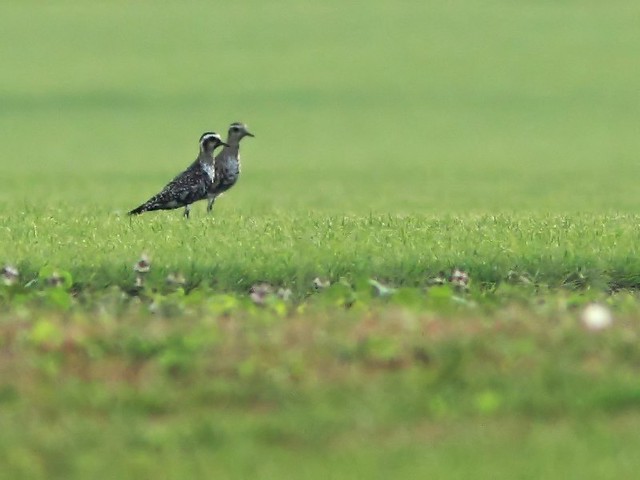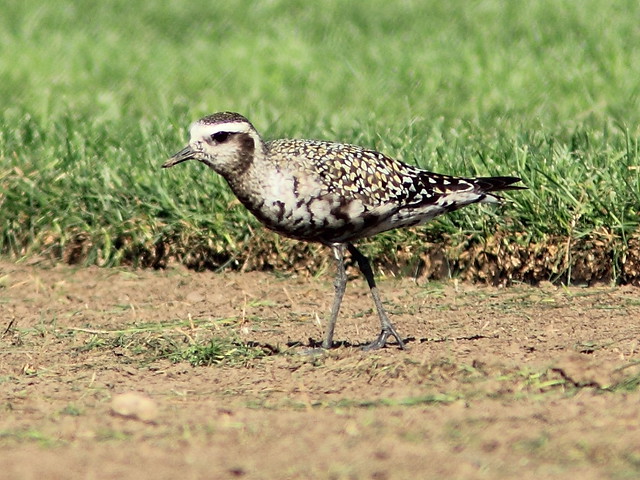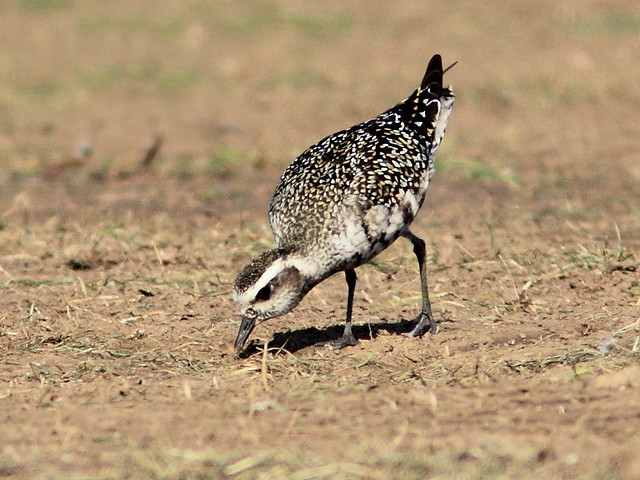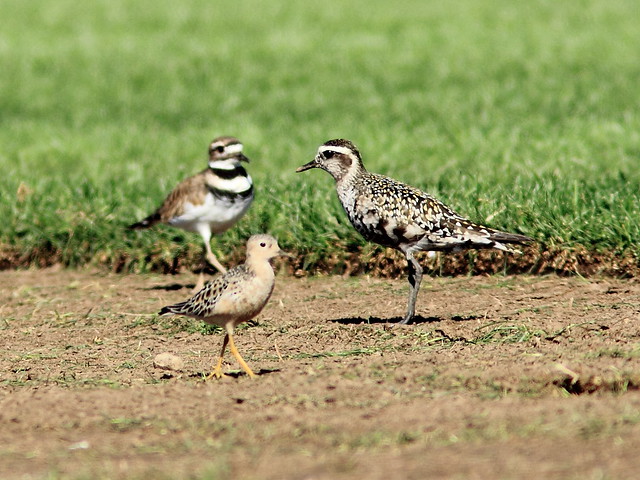Thanks to a heads-up from our friend Marion, we learned that they had appeared the day after we decided that it would be our last visit. As many as seven had been seen in a relatively inaccessible area of the huge sod farm.
Luckily, two golden-plovers were still there that next day. This is as close as I could get for a photo without entering private land (September 11, 2013).

Last year, an American Golden-Plover lingered next to the road, and our auto came in handy as a blind (or hide).


It joined a Killdeer and a Buff-bellied Sandpiper for a group photo opportunity.

Last year I prepared a video strip that tells more about this bird's remarkable journey. If you cannot see it below, try this link: https://vimeo.com/66256602
Beautiful photos of these shy birds.
ReplyDeletelove that trio!!!
ReplyDeleteHI Ken Great to see those 3 birds together.
ReplyDeleteLovely series, the plover and killdeer are so cute. And the Buff-bellied Sandpiper would be a new bird for me. Great post and photos, Ken!
ReplyDeleteWhat a thrill to see this amazing bird at the start of its long journey. The video worked perfectly; thank you.
ReplyDeleteThe group shot of the three is really wonderful too.
Beautiful!!! Y'know I'm really not sure I'd notice the difference between a black bellied and a golden plover. Is there something specific to tell them apart?!!
ReplyDeleteGreat images as always.
Good review of the Plovers!! Boom & Gary of the Vermilon River, Canada.
ReplyDeleteWhat a sweet little threesome. They look like they are going a little native dance. Wonderful post. genie
ReplyDeleteThe sod farm looks like a great hunting ground for the Golden Plover. Beautiful threesome.
ReplyDeleteAnni, the two species are quite similar. The Golden-plover is a bit smaller and (to my eye) looks slimmer and its head is proportionally smaller and beak thinner and a bit shorter than the Black-bellied Plover. This makes them look taller than the Black-bellied, which often looks more rounded (to me). The Black-bellied also has more coarse streaking on its breast in winter plumage. The yellowish color of the back on the American Golden-plover is usually more pronounced than on the Black-bellied, which also looks more grayish and not as warm in its winter plumage, although young Black-bellies can look quite "golden." The Black-bellied has black "armpits," white wing stripes (on the primaries) and whitish rump visible in flight, and these are the most reliable field marks. During migration the golden-plover is more common in the interior of the US and prefers to stop over in dry places like short grass prairie, potholes, golf courses and sod farms, while the Black-bellied is more commonly seen near large bodies of water. OK, you asked me what time it was and I told you how to make a watch!
ReplyDeleteAnni, the two species are quite similar. The Golden-plover is a bit smaller and (to my eye) looks slimmer and its head is proportionally smaller and beak thinner and a bit shorter than the Black-bellied Plover. This makes them look taller than the Black-bellied, which often looks more rounded (to me). The Black-bellied also has more coarse streaking on its breast in winter plumage. The yellowish color of the back on the American Golden-plover is usually more pronounced than on the Black-bellied, which also looks more grayish and not as warm in its winter plumage, although young Black-bellies can look quite "golden." The Black-bellied has black "armpits," white wing stripes (on the primaries) and whitish rump visible in flight, and these are the most reliable field marks. During migration the golden-plover is more common in the interior of the US and prefers to stop over in dry places like short grass prairie, potholes, golf courses and sod farms, while the Black-bellied is more commonly seen near large bodies of water. OK, you asked me what time it was and I told you how to make a watch!
ReplyDeleteNo...no, trust me Ken...this helped immensely!! Thank you. I'm gonna copy this that you wrote for me and save it. Maybe it'll help me notice the difference. IF I ever see a Golden Plover that is.
DeleteHow fortunate you were to see the golden plovers. My husband and I tried to see them twice at a sod farm an hour west of where we live...but no luck. Maybe next fall. ;))
ReplyDeleteLovely shots Ken.You caught the bird in interesting plumage too. Nice to see one next to Buff-bellied for comparison.
ReplyDeleteI visited Oahu in Hawaii a month ago and I saw a lot of Golden Plowers. They were everywhere. They seem to spend winter months there. I loved it because we rarely see them in Sweden.
ReplyDeleteGreat set of pictures - cars are a very good hide / blind. Like the video - what a busy bird.
ReplyDeleteCheers - Stewart M - Melbourne